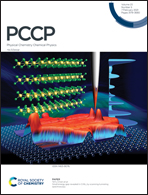New design strategy for chemically-stable blue phosphorescent materials: improving the energy gap between the T1 and 3MC states†
Abstract
A series of Ir- and Pt-based blue phosphorescent materials were theoretically investigated by means of density functional theory (DFT) calculations to improve their chemical stability in the excited state. High energy splitting between the lowest triplet state (T1 state), generally a metal-to-ligand charge transfer state (3MLCT), and the triplet metal-centred state (3MC) can prohibit ligand dissociation and suppress the decomposition reaction from the 3MC state to the dissociated S0. Here, we suggest a new design strategy to improve the chemical stability of blue phosphorescent materials in the excited state. Introducing inter- and intra-ligand interactions in Ir and Pt complexes can dramatically increase the ΔE(3MC-T1) because attractive or repulsive couplings arising from intra- or inter-ligand interactions can effectively prevent the out-of-plane bending vibrational mode in Ir complexes and the ring deformation vibrational mode in Pt complexes. A ΔE(3MC-T1) values of 18.62 kcal mol−1 for an Ir complex and 22.86 kcal mol−1 for a Pt complex from the T1 energy were obtained while the T1 energy was maintained in the blue region. To the best of our knowledge, these are the highest ΔE(3MC-T1) values reported to date. We believe that the present research provides profound insights into the excited state chemical stability of deep blue phosphorescent materials that could be implemented to improve device lifetimes.



 Please wait while we load your content...
Please wait while we load your content...